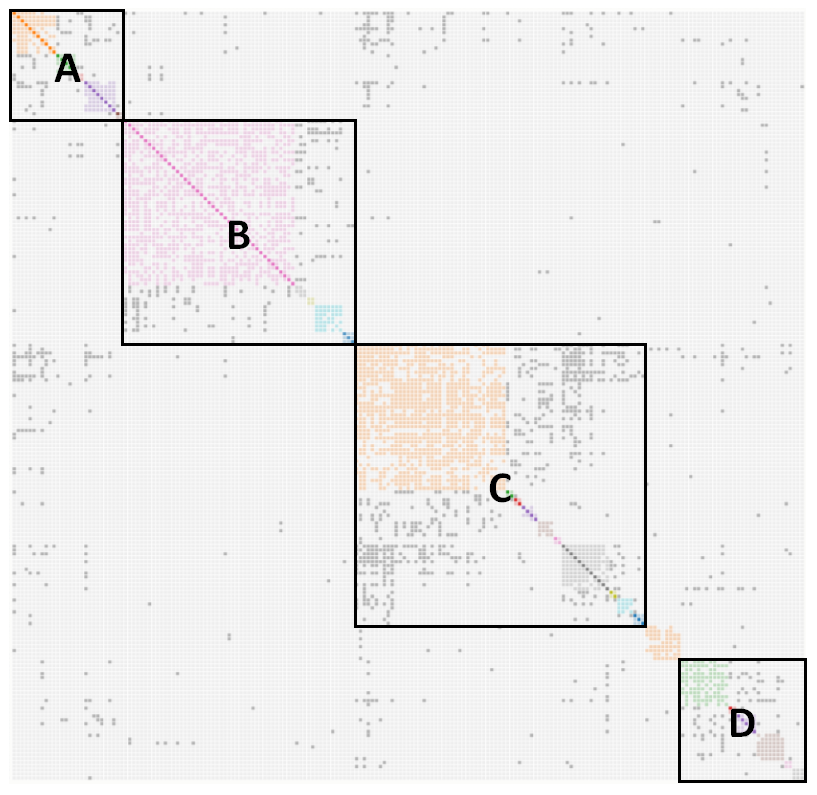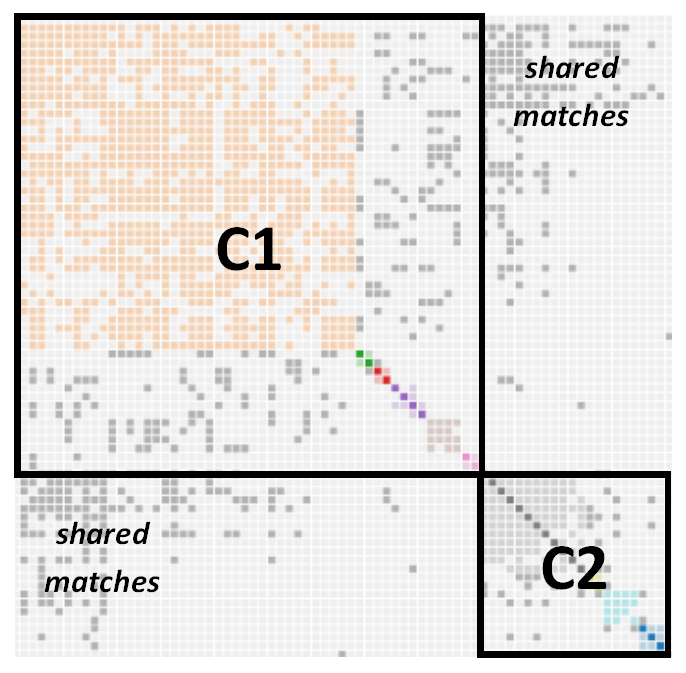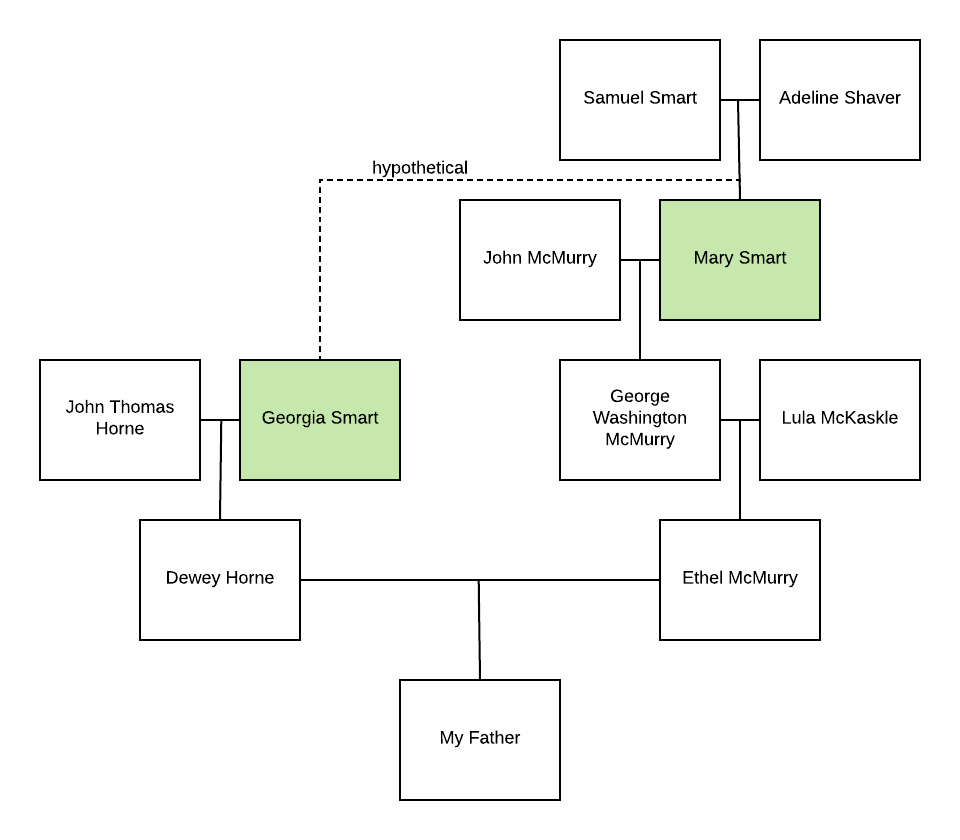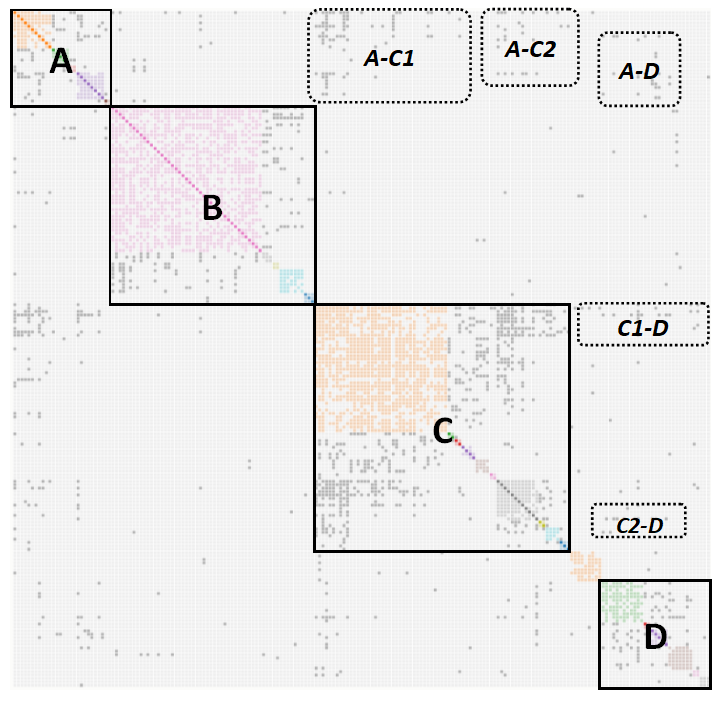This post is my third in a series about Genetic Affairs’ auto-cluster tool and using it to analyze my paternal matches at AncestryDNA. As you might recall, my father’s parents were likely first cousins, once removed (1C1R), meaning he has a high degree of pedigree collapse. I ran the auto-cluster tool on my father’s test at a range of 50 – 250 cM and previously identified four “super clusters”:

My earlier posts examined Super Cluster A and Super Cluster B and identified a MRCA — Most Recent Common Ancestor — for each. Today we’ll look at Super Cluster C.

Super Cluster C contains two distinct areas, labeled C1 and C2 on the chart above. I’ve grouped them together as a super cluster because of the large amount of shared matches between the two areas. This configuration is unique from my father’s other super clusters, so I already suspect it will contain matches in his Smart family — the line on which he has suspected pedigree collapse.
My father is directly descended from two Smart females: Mary Smart on his mother’s side, and Georgia Smart, on his father’s side. Traditional, paper evidence identifies Mary’s parents as Samuel Smart and Adeline Shaver, but Georgia’s parents are unknown. I have previously hypothesized they were sisters.

Two Smart females highlighted in green with hypothetical relationship as sisters
Will the auto-cluster results support or deny this theory? Let’s look at each area and determine a MRCA:
Super Cluster C-1 (clusters 11-16) = Shaver
- 52 members
- 50.1 – 228.3 cM
- can place 17 of 52 cousins on tree
- 1 descends from Samuel Smart & Adeline Shaver’s daughter Mary
- 4 descend from Samuel Smart & Adeline Shaver’s son Jim
- 2 descend from another hypothetical daughter of Samuel Smart & Adeline Shaver, Amarentha — One of these matches also shares Johnston ancestry with my father; the other shares both Johnston and McKaskle ancestors. (This is where the intermarriage gets quite messy!)
- 8 descend from Alfred Shaver & wife Sarah’s son John
- 1 descends from Peter Shaver and Susan Anderson’s son John
- 1 descends from Peter Shaver and Susan Anderson’s daughter Cynthia
- One member without a tree has the surname Shaver
- Conclusion: This super cluster contains descendants of Peter Shaver & Susan Anderson; the closest MCRAs for my father in this group are Samuel Smart and Adeline Shaver.
Super Cluster C-2 (cluster 17-20) = Smart
- 21 members
- 50.1 – 211.6 cM
- can place 6 of 21 cousins on tree
- 1 descends from Samuel Smart & Adeline Shaver’s son Jim
- 3 descend from James Smart & Ann Jane Knighton’s daughter Susan
- 1 descends from James Smart & Ann Jane Knighton’s daughter Sarah Ann Emmaline
- 1 descends from James Smart & Ann Jane Knighton’s daughter Margaret
- Conclusion: This super cluster contains descendants of James Smart & Ann Jane Knighton; the closest MCRAs for my father in this group are Samuel Smart and Adeline Shaver.
An interesting pattern I noticed on both C1 and C2 is that the generation closest to my father begins the cluster. The matches later in the cluster are one and two generations removed. Also, the areas with a high number of shared matches — the gray “noise dots” that almost form a wall where the beginning portions of C1 and C2 intersect — these areas seem to both represent descendants of Samuel Smart and Adeline Shaver.
I believe these clusters support the theory of Georgia Smart and Mary Smart as sisters. The only alternative theory that would result in such strong Shaver/Smart clustering is if Georgia were Mary’s daughter. Mary was approximately 16 years older than Georgia, so it’s biologically possible. The amount of shared DNA between my father’s parents — estimated as 482.8 cM — means either a 1C1R or a half-1C relationship is likely, which means Georgia and Mary were either mother/daughter or sisters. However, Georgia as Mary’s daughter would have introduced an unidentified father, and I would have expected a cluster representing descendants of this ancestor and his family somewhere in the auto-cluster results — either grouped within Super Cluster C or in another, separate cluster. Such a cluster would have “gray dot noise” indicating a connection between it and the Shaver/Smart cluster. I don’t see an indication of such a cluster that could be a father for Georgia.
But what about those shared matches between C1/C2 and Super Cluster A and even a few scattered around Super Cluster D? If you caught those, you have a good eye! I’ve labeled these areas with dotted lines below:

Unfortunately, my father’s pedigree collapse isn’t as easy as just one family. Another hypothetical daughter of Samuel Smart and Adeline Shaver — Amarentha Smart — is a key player in this tangled web. She married and had children with William Silas Johnston, one of the MRCAs from Super Cluster A. Two of their children married spouses who were McKaskles, also represented by MRCAs in Super Cluster A, as well as Super Cluster D (the next blog post in this series). I believe these areas of concentrated matches can all be attributed to Amarentha’s children’s intermarriage. If so, the lack of additional shared matches with the Shaver/Smart super cluster supports Georgia as Mary’s sister, and daughter of Samuel Smart and Adeline Shaver.
Will I ever have enough evidence to consider the parentage of Georgia Smart solved? Probably not — at least not with DNA only. I continue to search for traditional, paper evidence to solve this mystery. And I try any new DNA tools that come along in the mean time.
What do you think — were Georgia and Mary sisters? I welcome any feedback and insights!

Hi Jessica,
That Georgia and Mary were sisters is certainly a reasonable hypothesis to begin with, based on what your supercluster C is showing you. (Don’t you wish sometimes the DNA could just give you the answer, lol?)
I find reading about other folks’ DNA clusters and their analysis fascinating, because it just shows how random DNA inheritance really is. With my own father’s results, everyone (from Ancestry) in a 75 – 250 cM range is in the same cluster, and most of the rest of the clusters are tiny (3 – 4 people at most). The best I can do is identify that they relate to my father’s paternal grandmother’s line.
I have had much better luck with the Shared Clustering tool of Jonathan Brecher; have you used that one? (He must be using a different algorithm than Evert-Jan Blom.) The (distant) endogamy on my father’s paternal grandmother’s line shows up quite clearly. (However, I still have the same issue of not enough traditional genealogy done on that line, so I cannot entirely identify ancestral couples.)
Excellent series of clustering posts!